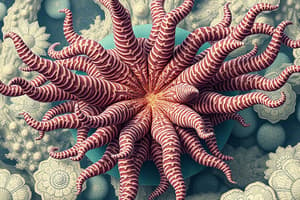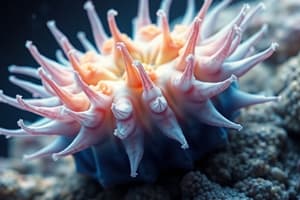Podcast
Questions and Answers
What are the characteristics of the Phylum Echinodermata?
What are the characteristics of the Phylum Echinodermata?
- Arms in multiples of 5 (correct)
- 100% marine (correct)
- Spiny skinned (correct)
- Adults monomorphic (correct)
What are the Echinoderm Classes?
What are the Echinoderm Classes?
Asteroidia, Ophiuroidea, Echinoidea, Holothroidea, Crinoidea
What are the characteristics of Asteroidia?
What are the characteristics of Asteroidia?
Sea stars, predatory, top and bottom body, water vascular system.
What are the characteristics of Ophiuroidea?
What are the characteristics of Ophiuroidea?
What are the characteristics of Echinoidea?
What are the characteristics of Echinoidea?
What are the characteristics of Holothuroidea?
What are the characteristics of Holothuroidea?
What are the characteristics of Crinoidea?
What are the characteristics of Crinoidea?
What is Evisceration?
What is Evisceration?
What Echinoderm class is known for its Evisceration habits?
What Echinoderm class is known for its Evisceration habits?
What is Cloacal Respiration?
What is Cloacal Respiration?
What Echinoderm class is known for its Cloacal Respiration habits?
What Echinoderm class is known for its Cloacal Respiration habits?
What are Cuvierian Organs?
What are Cuvierian Organs?
What Echinoderm class is known for its Cuvierian Organs?
What Echinoderm class is known for its Cuvierian Organs?
What Echinoderm class is known for its fleshy tentacles?
What Echinoderm class is known for its fleshy tentacles?
What Echinoderm class is known for its Holothurin Secretion?
What Echinoderm class is known for its Holothurin Secretion?
What is Uni?
What is Uni?
What Class does Uni fall under?
What Class does Uni fall under?
What is Trepang?
What is Trepang?
What is Beche de Mer?
What is Beche de Mer?
What Class does Trepang fall under?
What Class does Trepang fall under?
What Class does Beche De Mer fall under?
What Class does Beche De Mer fall under?
What Class does Pantamery fall under?
What Class does Pantamery fall under?
What Class does Radial Symmetry fall under?
What Class does Radial Symmetry fall under?
Flashcards are hidden until you start studying
Study Notes
Characteristics of Phylum Echinodermata
- Organisms are spiny-skinned, fully marine creatures.
- Have bilateral symmetry as larvae but exhibit pentamerous (five-part) symmetry as adults.
- Possess a water vascular system that includes tube feet for locomotion.
- Monomorphic in adults, meaning they have similar body forms regardless of gender.
- Feature spines and jawed structures called pedicellariae for protection and feeding.
Echinoderm Classes
- Five primary classes: Asteroidea, Ophiuroidea, Echinoidea, Holothuroidea, Crinoidea.
Characteristics of Asteroidea (Sea Stars)
- Known for their predatory nature; feature both top (aboral) and bottom (oral) surfaces.
- Water is pumped into their bodies via a madreporite for movement.
- Unique feeding strategy involves extruding their stomachs to digest prey such as clams and oysters.
- Regenerate lost arms; primary predators include triton snails and specific shrimp.
Characteristics of Ophiuroidea (Brittle Stars)
- Possess a pentamerous body structure.
- Well-known for their ability to regenerate lost arms.
- Some species, like basket stars, display dome-shaped structures with dichotomous branching.
- Diet consists of plankton and flesh, functioning as carnivores.
Characteristics of Echinoidea (Sea Urchins)
- Display a round body with calcareous structures.
- Characterized by "test" — the fused skeletal structure, and mouths equipped with five jaws known as Aristotle's lantern.
- Notable species include black sea urchins and purple urchins, the latter sometimes harvested for sushi (uni) and roe.
- Sand dollars show unique behavior of returning to preferred habitats within the ocean.
Characteristics of Holothuroidea (Sea Cucumbers)
- Exhibits body shapes that can extend with 5-15 tentacles, some reaching up to 8 feet in length.
- Feed on detritus and bacteria, often having very long intestines.
- Unique respiratory mechanism allowing for breathing through the anus.
- Known for secretions, such as holothurin, which acts as a numbing agent.
Characteristics of Crinoidea (Feather Stars)
- Recognized as the most primitive class within Echinodermata.
- Found in coral environments; important in fossil records.
- Have a dorsal cup shape with numerous arms surrounding the mouth, with separate sexes.
Evisceration
- A defensive mechanism where sea cucumbers expel internal organs to deter predators.
- Key example includes the sea cucumber ejecting its intestines when threatened.
Cloacal Respiration
- A unique respiratory adaptation where organisms like sea cucumbers and turtles breathe through the anus.
Cuvierian Organs
- Specialized sticky and toxic structures located in the digestive system of sea cucumbers.
- Expelled through the anus as a defense mechanism, confusing predators while the organ can regenerate.
Unique Versatile Echinoderm Products
- Uni: Sea urchin eggs, regarded as a delicacy in sushi.
- Trepang: Edible sea cucumber in Asian cuisine, thought to be an aphrodisiac.
- Beche de Mer: A term for sea cucumber in French Southeast Asia, also related to aphrodisiac qualities.
Class Associations
- Uni falls under Echinoidea.
- Trepang and Beche de Mer belong to Holothuroidea.
- Pantamery pertains to Ophiuroidea, specifically brittle stars.
- Asteroidea exemplifies instances of radial symmetry.
Studying That Suits You
Use AI to generate personalized quizzes and flashcards to suit your learning preferences.




